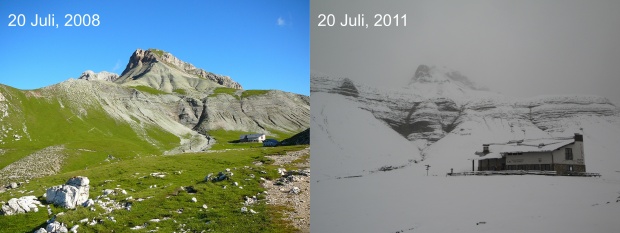Mountains sure aren´t what they used to be. Take the Dolomites in the Veneto Region of Italy and Austria; 140 to 90 million years ago, they were part of the sea floor rather than mountains.
Over millions of years, deposits were then formed from calcareous shells of marine life from the Mesozoic era. Tectonic forces later caused these sediments to rise upward to the mountaintops of today´s well-known and popular Southern Alps. The mountain range contains one of the most complete and most accessible geological records - also being one of the richest in fossils - from the Cretaceous period in Europe. This record was scientifically analyzed in-depth for the first time within the framework of a project supported by the Austrian Science Fund FWF.
In addition to basic analyses of the deposits, researchers also examined questions regarding the habitat and the biology of the original marine life, as well as the climatic conditions which existed at the time.
Over millions of years, deposits were then formed from calcareous shells of marine life from the Mesozoic era. Tectonic forces later caused these sediments to rise upward to the mountaintops of today´s well-known and popular Southern Alps. The mountain range contains one of the most complete and most accessible geological records - also being one of the richest in fossils - from the Cretaceous period in Europe. This record was scientifically analyzed in-depth for the first time within the framework of a project supported by the Austrian Science Fund FWF.
In addition to basic analyses of the deposits, researchers also examined questions regarding the habitat and the biology of the original marine life, as well as the climatic conditions which existed at the time.
Initial results of the research project are now presented in a rather unusual way; as part of the exhibition entitled "Dolomiten - Das steinerne Herz der Welt" (Dolomites - the Stone Heart of the World), beginning today, along with 50 photos by National Geographic photographer Georg Tappeiner and a film.

The Dolomites in 2008 and 2011. Notice anything different? © Alexander Lukeneder
Senior researcher Dr. Alexander Lukeneder from the Geological and Paleontological Department of Vienna´s Museum of Natural History says, "When conveying the results of our research, we find it important to also present the adventure of research and its beauty, in addition to factual data. Georg Tappeiner´s beautiful photos capture the breath-taking aesthetics of the Dolomites. The film of the palaeontology team captures more than the attractiveness of research objects. It shows the difficulties and efforts of conducting research far from any infrastructure, in extreme cold and 3000m above sea level. This almost makes our results seem secondary."

The Dolomites in 2008 and 2011. Notice anything different? © Alexander Lukeneder
Senior researcher Dr. Alexander Lukeneder from the Geological and Paleontological Department of Vienna´s Museum of Natural History says, "When conveying the results of our research, we find it important to also present the adventure of research and its beauty, in addition to factual data. Georg Tappeiner´s beautiful photos capture the breath-taking aesthetics of the Dolomites. The film of the palaeontology team captures more than the attractiveness of research objects. It shows the difficulties and efforts of conducting research far from any infrastructure, in extreme cold and 3000m above sea level. This almost makes our results seem secondary."
Some of the results are spectacular. Lukeneder´s international team proved that sea temperatures in the Mediterranean area rose by 10 to 12 degrees Celsius during the Lower Cretaceous period 140 to 90 million years ago. "We were able to prove this extreme greenhouse effect by means of special analyses of the calcareous stone. The origin of this stone lies in the deposits of dead nanoplankton and the sedimentation of calcareous microfossils, like the foraminifera," says Lukeneder. While the marine organisms were still alive, oxygen was incorporated into their calcareous shells. The oxygen isotope ratio (18O to 16O) depended on the temperature of the surrounding water. The process of fossilization preserved this biological thermometer perfectly for millions of years.
"HIGH" RESOLUTION
The overall aim of the project was to conduct a high-resolution mapping of the Dolomites´ deposits from the Lower Cretaceous at 2500m above sea level. This included not only the analysis of macro- and microfossils and the isotope ratios, but also the study of rock layers (Puez Formation) and their magnetic relationships, as well as the influence of various cycles during the formation of these layers.
The team consisting of 32 researchers focused especially on an area in the Puez-Geisler Nature Park, which was declared a World Natural Heritage site by UNESCO in 2009. The current exhibition at the Museum of Natural History Vienna shows, in a very impressive way, that this heritage site comprises both natural beauty and a data archive from the Cretaceous period that is many million of years old.
The team consisting of 32 researchers focused especially on an area in the Puez-Geisler Nature Park, which was declared a World Natural Heritage site by UNESCO in 2009. The current exhibition at the Museum of Natural History Vienna shows, in a very impressive way, that this heritage site comprises both natural beauty and a data archive from the Cretaceous period that is many million of years old.






Comments